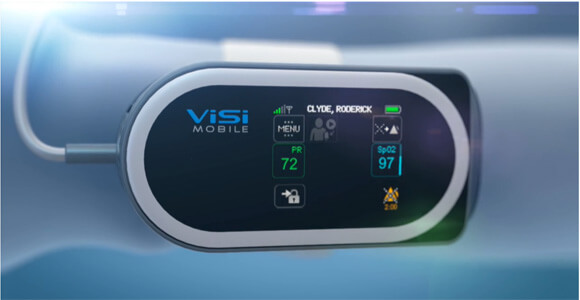
The benefits of mobile technology in a healthcare setting have not, it’s safe to say, gone unnoticed. A throng of companies is trying to turn the smartphone into an assortment of medical devices, from blood pressure cuffs to otoscopes. Such devices offer patients a chance to keep up with chronic conditions and send data to their doctors on occasion.
But go to a hospital intensive care unit and what you’ll see are bulky machines not very different from what you saw on ER in the 1990s. The reasons are institutional: hospitals buy in bulk, and they can only buy devices that are precise and proven.
But mobile vital sign monitors are at last making inroads inside the hospital walls. Sotera Wireless’s ViSi mobile monitor, recently adopted by a San Diego hospital and a few other sites, takes the functions of those enormous beeping bedside machines and puts them in a smartphone-sized oval the patient wears on his or her wrist.
It’s a pretty basic idea: Take a big machine and make it small. (Sotera isn’t the first to venture in this direction, but its device is significantly smaller and sleeker than previous attempts). Yet, in a hospital setting, such a small change can have big effects.
According to Sotera, ViSi allows hospitals to move patients out of intensive care units more quickly. Most hospitals do continuous monitoring exclusively in intensive care units. The heart rate, blood oxygen and other monitors are expensive and non-mobile, so they only make sense only when the patient is very sick and not very mobile. With mobile monitoring, doctors and nurses don’t have to fly blind when they move patients into other, less cost-intensive units.
 But cost is just one problem with hospitals, at least in the United States. Hospitals can be a lousy place to heal. The food is lousy and dangerous “superbugs” can prey on the sick. And patients aren’t able to get the sleep they need between the constant beeps of machinery and the regular wake-up calls of nurses looking to check their vital signs by hand.
But cost is just one problem with hospitals, at least in the United States. Hospitals can be a lousy place to heal. The food is lousy and dangerous “superbugs” can prey on the sick. And patients aren’t able to get the sleep they need between the constant beeps of machinery and the regular wake-up calls of nurses looking to check their vital signs by hand.
Sotera can’t do much about the first two, but it can do a lot about that last one.
With real-time monitoring, nurses don’t have to do routine bedside checks to ensure that the patient’s vital signs are normal and patients don’t have to be woken up periodically during the night. By saving the readout numbers directly to the patient’s electronic health record, ViSi dramatically reduces the chances that an incorrect (or illegible) number will confuse subsequent care.
“Alarm fatigue” is another growing problem in hospitals. Every monitor can trigger an alarm that requires nurses to come check the patient. The trouble is 7 in 10 hospital alarms turn out to be false, so overworked nurses sometimes turn off or ignore the alarms.
Could mobile monitoring help with alarm fatigue? Perhaps. Like other monitors, ViSi has alarms. But research says that algorithmic alarms that “take into account multiple parameters, rate of change, and signal quality” can cut back on the number of false alarms. ViSi also allows clinicians to customize alarm thresholds and to set alarm delays that let patients turn off alarms that are triggered by movement, for example.
Whether it’s Sotera or another company leading the charge, it seems that smart, mobile patient monitors are an idea whose time has come.
Images: Sotera Wireless



